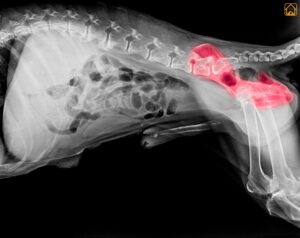Dog Pregnancy Overview: What Is Canine Gestation?
Dog pregnancy, also called canine gestation, is the period when a female dog carries developing puppies inside her uterus. This process is shorter than in humans and brings rapid changes, both physical and behavioral. The dog gestation period is packed with milestones, each week brings something new, from subtle early signs to more obvious changes as her belly grows and she prepares for whelping.
Canine pregnancy isn’t just about puppies on the way; it’s a time when your dog will need extra care, attention, and a little bit of loving care. Whether you’ve bred your dog intentionally or you’re facing an unexpected litter, understanding the basics can ease your mind.
Understanding the Canine Reproductive Cycle
Before a dog becomes pregnant, she goes through a reproductive cycle. Knowing the cycle helps you recognize when your dog is fertile, when she can become pregnant, and what changes to expect.
| Stage | Duration | Main Features |
| Proestrus | 6–11 days (can vary) | Swollen vulva, bloody discharge, attracts males, won’t mate yet |
| Estrus (“Heat”) | 5–9 days (may range 3–21 days) | Females are receptive to mating, ovulation occurs, discharge lessens. This is when dog pregnancy is possible. |
| Diestrus | ≈ 60 days | Pregnancy or false pregnancy (dog phantom pregnancy) develops |
| Anestrus | 4–12 months | Resting phase before next cycle. The reproductive system “resets” in preparation for the next cycle. |
Understanding your dog’s cycle helps you plan breeding, avoid accidental pregnancies, and provide proper care.
How Long Are Dogs Pregnant? Gestation Period Explained
Understanding Canine Gestation Time
So, how long is dog pregnancy? Most dogs are pregnant for about 63 days, or roughly two months. The canine gestation period typically ranges from 57 to 65 days, depending on the individual dog, breed, and litter size. Some may go a little earlier or later, but 63 days is the average.
It’s common to wonder, “How many months are dogs pregnant?” The answer is just over two months. This short window means every week matters! The dog gestation stages move quickly, from fertilization to puppies ready to greet the world.
- Small breeds: Sometimes deliver on the shorter end of the range.
- Large breeds: May carry longer, especially with large litters.
Here is a quick table to understand the Dog Gestation period.
| Stage | Gestation Time |
| Early pregnancy | Days 0–21 |
| Mid-pregnancy | Days 22–42 |
| Late pregnancy | Days 43–65 |
Tracking the mating date helps predict the due date. If you’re unsure, your veterinarian can estimate using ultrasound or abdominal palpation.
Dog Pregnancy Timeline & Stages: Week-by-Week Changes
Dog Pregnancy Week by Week
Ever wondered what’s happening inside your dog each week? Here’s a quick breakdown of the dog pregnancy timeline and stages:
| Weeks | Changes & Milestones |
| Weeks 1-2 | Fertilization and implantation. No visible changes yet; some dogs may seem a little tired or moody. |
| Weeks 3-4 | Embryos attach to the uterus. Mild symptoms may appear: appetite changes, mild nausea, or subtle behavioral shifts. |
| Weeks 5-6 | Rapid puppy growth. Abdomen starts to round; nipples may enlarge. Some notice weight gain. |
| Weeks 7-8 | Puppies develop fur and skeletons. Belly swells, nesting behavior begins, and mother may become more affectionate or restless. |
| Week 9 | Final preparations for birth. Milk production starts, visible puppy movement, and clear signs of nesting. Labor can begin any day. |
I still laugh remembering how my dog collected every sock in the house during week 8, her way of “nesting.” Every dog is unique, but these stages are a helpful guide.
Early Signs and Symptoms of Dog Pregnancy
How to Spot the First Clues
Detecting dog pregnancy in the first few weeks can be tricky. Many symptoms are subtle, especially at week 1 or 2. Here are the most common early signs to watch for:
- Swollen, pink nipples (“pinking up”)
- Vomiting (mild, like morning sickness)
- Mild abdominal swelling
- Changes in appetite (decrease or increase)
- Behavioral changes like clinginess, irritability, or nesting
- Weight gain (up to 15–25% over pre-pregnancy weight)
- Clear vaginal discharge in later stages
- Milk production near term
Not all dogs show every sign, sometimes, it’s just a gut feeling. I remember staring at my dog, convinced she looked “different,” even before the vet confirmed it!
Before pregnancy even begins, it all starts with the heat cycle. Explore our detailed guide on the dog heat cycle to know when your pup is most fertile.
Diagnosing Dog Pregnancy: Tests and Vet Exams

Options for Confirming Canine Pregnancy
If you’re asking, “How to tell if your dog is pregnant at home?”, the truth is, reliable diagnosis often requires a vet. Home dog pregnancy tests aren’t as accurate as human tests. Here are the main ways vets diagnose pregnancy in dogs:
- Abdominal palpation: Vet feels for “grape-like” swellings after 28 days.
- Ultrasound: Detects embryos as early as day 21; also checks for heartbeats.
- Blood test (Relaxin): Detects pregnancy hormone from day 22-27.
- X-ray (Radiograph): Best after day 45 to count puppies.
DIY “dog pregnancy test at home” kits exist, but they’re not as trustworthy. For peace of mind, consult your veterinarian. They can also rule out false pregnancy, which can mimic real symptoms but doesn’t result in puppies.
Nutrition & Diet for Pregnant Dogs
Feeding for Healthy Puppies and Mom
Diet for pregnant dogs is crucial for both mom and her growing pups. For the first five weeks, most dogs can stay on their normal high-quality dog food (look for AAFCO “all life stages” or “gestation and lactation” labels). From week 6, switch to a calorie-dense puppy food or a specific dog food for pregnant dogs.
- Feed several small meals per day, her belly won’t have much room for big meals!
- Discuss prenatal supplements with your vet (don’t add vitamins or calcium unless advised).
- Ensure water is always available.
- Omega-3s, especially DHA, can support puppy brain development, ask your vet about DHA-rich diets.
| Stage of Pregnancy | Diet Recommendations |
| Weeks 1–5 | Normal adult maintenance food; no extra food needed if weight is stable |
| Weeks 6–9 | Transition to calorie-dense puppy food to meet her growing energy needs. |
| Lactation (after birth) | Continue growth food; may need up to 2–4x her normal calories |
Remember, overfeeding early in pregnancy can be risky, but underfeeding in late pregnancy is also a concern. I once learned the hard way that my dog needed smaller, more frequent meals when she started looking uncomfortable after eating her usual dinner.
Exercise, Vet Visits, and General Pregnancy Care

Safe Exercise for Pregnant Dogs
Exercise during dog pregnancy helps keep your dog fit, but intensity should be adjusted. Here are the stage wise exercise recommendations.
- Early Pregnancy: Maintain normal activity levels, gentle walks and light play are perfect.
- Late Pregnancy: Let your dog set the pace. As she grows larger, shorter, more frequent walks may be best. Avoid rough play, jumping, or strenuous exercise.
- Rest: Provide a soft, quiet spot for her to nap and nest undisturbed.
Veterinary Care and Health Monitoring
- Keep up with prenatal vet visits to monitor health and development.
- Use only products approved by your vet for pregnant dogs. Some flea, tick, or worm treatments are unsafe during pregnancy.
- Ideally, your dog should be up to date before pregnancy, as some vaccines aren’t safe during gestation. Discuss with your vet if you’re unsure.
- Watch for unusual discharge or changes; contact your vet if you’re concerned.
Your dog may also become more affectionate or want extra quiet time. Let her set the pace for cuddles and rest. I’ve noticed some dogs get a bit “clingy”, like they know big changes are coming and want to stick close.
Preparing for Whelping: Supplies, Nesting, and Labor
Getting Ready for Puppies
The final weeks of dog pregnancy are all about preparation. As your dog nears her due date, you’ll want to create a safe, comfortable space for her to give birth—and know what signs signal that labor is near.
- Whelping box: Large enough for mom to stretch out, with low sides for easy access.
- Liners: Newspaper, old towels, or puppy pads for easy cleanup.
- Heat source: Puppies need warmth, consider a heating pad under half the box (never leave it on full or unattended).
- Clean scissors and dental floss: For emergency cord cutting and tying (if mom doesn’t do it herself).
- Digital thermometer: To monitor your dog’s temperature as her due date approaches.
- Contact information for your vet and emergency clinic: Have this on hand in case of complications.
Recognizing Signs of Labor
Watch for these signs that your dog is about to give birth:
- Drop in body temperature: Her rectal temperature will fall below 99°F (37.2°C) about 8–24 hours before labor.
- Restlessness and nesting: She may dig, circle, or try to make a “nest.”
- Loss of appetite: Many dogs refuse food in the 12–24 hours before labor.
- Panting and trembling: Increased pacing, panting, or shivering are common as contractions begin.
- Clear or slightly bloody discharge: A light discharge can mean labor is near, but if it’s heavy, green, or smells bad before any puppies arrive, it’s a red flag. Call your vet immediately, it could be an emergency.
Introduce your dog to the whelping box a week or two before her due date. Set it up in a quiet, cozy spot like a laundry room or corner of a home office. If she tries nesting elsewhere, gently guide her back with patience and maybe a few treats to make it inviting.
Pro Tip: Keep the area calm and limit visitors. Pregnancy is a private affair for many dogs, and too much chaos can stress her out.
Potential Pregnancy Complications & When to Call the Vet
Know the Warning Signs
Most dogs handle pregnancy and whelping well, but problems can happen. Contact your veterinarian right away if you notice:
- Straining for over 30-60 minutes with no puppy produced
- Green, foul-smelling, or bloody discharge before puppies arrive
- More than two hours between puppies
- Obvious pain, distress, or collapse
- Excessive weakness, vomiting, or fever
It’s always better to ask a Vet, even if it turns out to be a false alarm. And yes, I’ve called my vet at 3 a.m. before. No shame!
After welcoming those warm little puppies into the world, don’t miss our Puppy Food Guide to help them grow up healthy, strong, and full of tail wags.
FAQs About Dog Pregnancy
How long are dogs pregnant?
Most dogs are pregnant for about 63 days (roughly two months). The dog gestation period can range from 57 to 65 days, depending on the breed and individual dog.
What are the first signs of dog pregnancy?
Early signs include mild appetite changes, slight lethargy, subtle behavioral shifts, and swollen nipples. Some dogs show almost no symptoms in the first few weeks.
Can I use a dog pregnancy test at home?
Home test kits exist but aren’t very accurate. The most reliable ways to confirm dog pregnancy are blood tests for relaxin, ultrasound, or abdominal palpation by a veterinarian.
What should I feed my pregnant dog?
Feed a high-quality, balanced diet approved for gestation and lactation. In the last trimester, switch to puppy or reproduction dog food. Ask your vet before adding supplements.
Is it safe to exercise my pregnant dog?
Yes, gentle exercise is good. Avoid strenuous activity, especially as the belly grows. Short, regular walks help keep her fit and comfortable.
How can I prepare for my dog’s labor?
Set up a whelping box in a quiet area, gather supplies (like towels, heat source, clean scissors), and introduce your dog to her new spot about a week before her due date.
What if my dog shows signs of trouble during pregnancy or labor?
Call your vet immediately if you see straining without delivering the puppies, odd discharge, long gaps between puppies, or signs of pain or distress. Fast action can save lives.
Do dogs need supplements during pregnancy?
Usually not, if you’re feeding a high-quality, balanced diet. Only give supplements if your vet specifically prescribes them.
What are signs my dog is about to give birth?
Look for nesting, restlessness, panting, a drop in appetite, and a temperature drop below 99°F. These all mean labor is likely within a day.
Can my dog have a false pregnancy?
Yes! Phantom pregnancies are common and mimic real pregnancy symptoms, but no puppies are produced. If you’re unsure, your vet can confirm with a test.
How do I know how many puppies to expect?
Late-pregnancy X-rays (after day 45) are the best way to get an accurate puppy count.
Is it safe to spay my dog during pregnancy?
It’s possible, but timing and risk factors matter. If you’re not planning future litters, discuss options with your vet as soon as possible.
Can I use a human pregnancy test on my dog?
No. Human tests look for hCG, which dogs don’t produce. Only veterinary tests and exams can reliably diagnose dog pregnancy.
How can I take care of my dog during pregnancy?
Taking care of a pregnant dog means giving her the right food, gentle exercise, and regular vet check-ups. You should also learn what to expect at each stage of pregnancy. For a clear and helpful overview, check out the AKC Dog Pregnancy Guide.
Conclusion
Dog pregnancy brings its share of questions, surprises, and heartwarming moments. With the right care, attention, and support, you’ll help your dog have a healthy pregnancy and welcome those adorable puppies into the world. Remember, you’re not alone on this journey, lean on your vet, trusted resources, and your own instincts as a loving pet parent.



